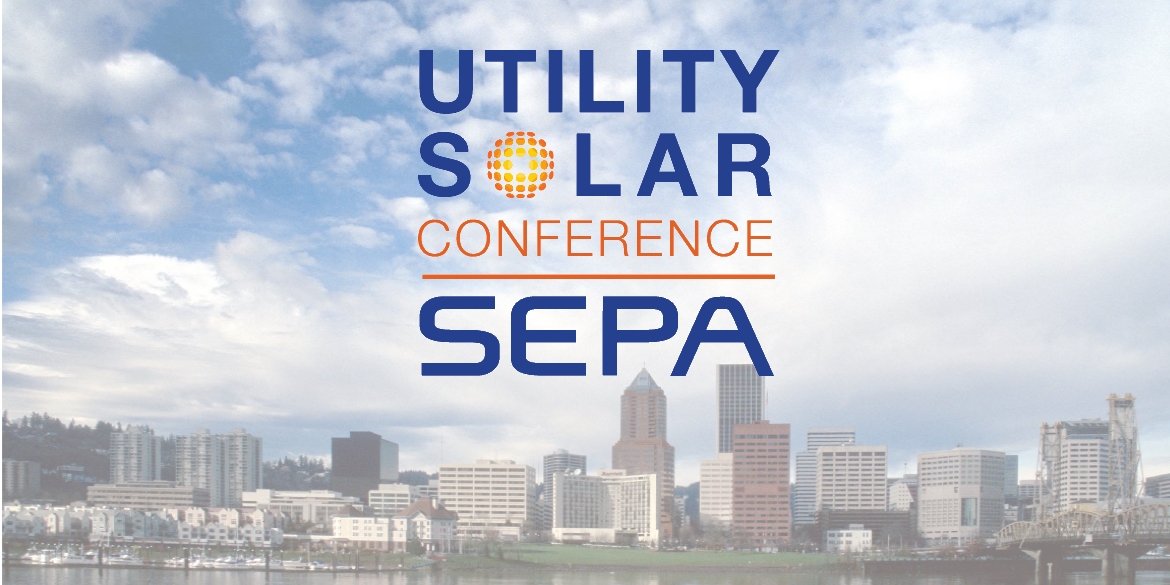The Solar Electric Power Association (SEPA) Utility Solar Conference (USC) was held last month in Portland, Ore. This was convenient for our Kirkland, Wash., software team, so we sent four people down to join Tom Hoff from our Napa, Calif., office at the event. It was also refreshing to see Pacific Northwest ut ilities well represented by Puget Sound Energy, Snohomish County PUD, Seattle City Light and Portland General Electric (PGE being the “host” utility, of course).
ilities well represented by Puget Sound Energy, Snohomish County PUD, Seattle City Light and Portland General Electric (PGE being the “host” utility, of course).
As its name suggests, the USC is very much a utility-oriented conference and even has a day of sessions that is for ‘utilities only’. With attendance in the hundreds, the USC is collegial and purposeful rather than overwhelming. The value of the conference to utilities is well-evidenced by the fact that several utilities send ten or more folks each year.
Clean Power Research participated in sessions on solar forecasting and the inaugural PowerClerk® Users’ Group. Some takeaways from the conference include:
- Value of Solar™ discussions are focused on consistency and transparency. Utilities are considering the impact and value of solar energy generation—both distributed and central station—in their service territories. This is becoming a familiar topic in the industry. Many utilities I’ve spoken with say they are looking to understand the components of cost and value in a quantitative way that is consistent with how they analyze the return on investment of other aspects of their operations (e.g., traditional generation, T&D, customer servicing costs, etc.), and that considers legislative or regulatory mandates (e.g., renewable portfolio standards) as part of the calculus.
For utilities or other interested industry groups that want to consider the Value of Solar (VoS) from this quantitative perspective and include other aspects of cost and value, our approach combines consulting and software in a modular and transparent way through our DGValuator™ software tool.
- Utilities are investigating methods of integrating distributed solar onto the grid. While VoS gets at the issues around long-term value and impact of solar, utilities are not shying away from the more immediate challenges of solar integration. High levels of distributed and central station PV have implications on their traditional operations, including interactions with independent system operators (ISOs) and/or balancing area authorities. Thus, especially in higher penetration PV environments like California and Hawaii, there is much interest in analytical approaches that can accurately and efficiently model solar for planning purposes and to forecast output.
The solar forecasting session at the USC that Clean Power Research was involved in proved to be a lively discussion, with several approaches being reviewed. This included SolarAnywhere® FleetView™, our fleet management and forecasting package that is being evaluated under a California Solar Initiative (CSI) contract for the California Independent System Operator (CAISO).
- Administrators of new solar incentive programs are reaping the benefits of early program successes. While incentive programs are winding down in some of the early PV markets (e.g., CSI in California), other markets, such as the southern U.S., are heating up. The utilities from those regions are asking intelligent questions and learning from the efforts of their utility colleagues around the country.
Incentives today may be lower than the early days of programs in places like California or New Jersey, but there are a lot of best practices to be shared. These range from a fundamental level (e.g., FiT vs. up front incentive), to the nuances of actually administering a program. We were pleased to hear PowerClerk mentioned in many of these discussions; after seven years in the market, PowerClerk is a repository of many of the best practices around incentive programs.
SEPA does a great job making sure that all utility participants—regardless of size or where they stand with solar in their service territories—have an opportunity for frank discussions that are unfettered by the presence of commercial interests. That said, SEPA also welcomes the participation of solution providers who sponsor collaboration sessions, meals and other events through the conference. We were pleased to see several CPR customers on the list of solution providers.
Of course, the CPR team was not omnipresent at the USC and so the topics mentioned above are undoubtedly only a few of the interesting subjects discussed during the conference. What is clear is that SEPA has made the USC a “go-to” event for thoughtful discussion…and the interesting topics seem to change every year. We look forward to the USC in Newport Beach next year.
